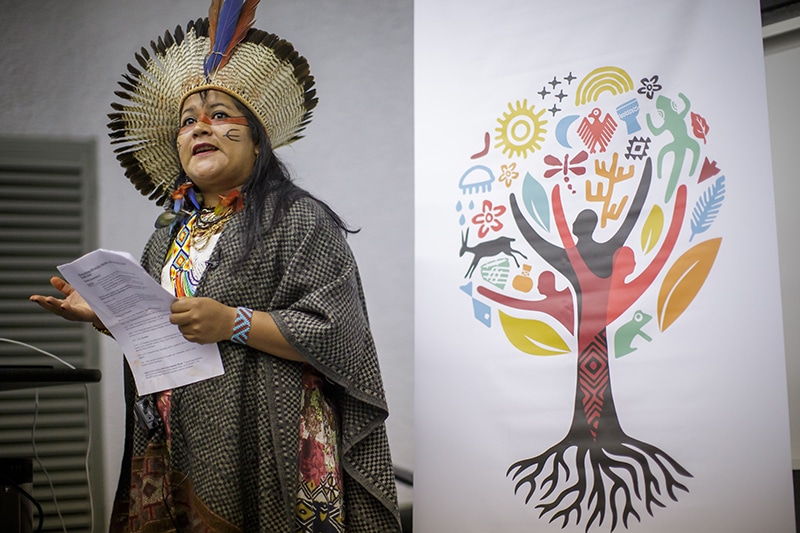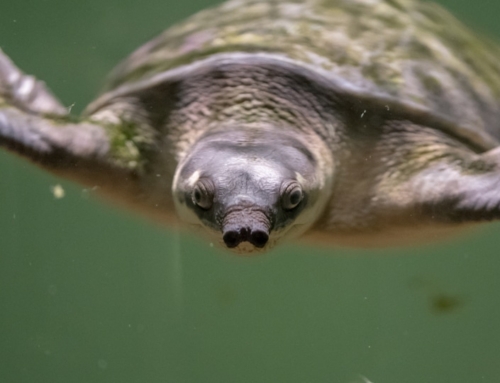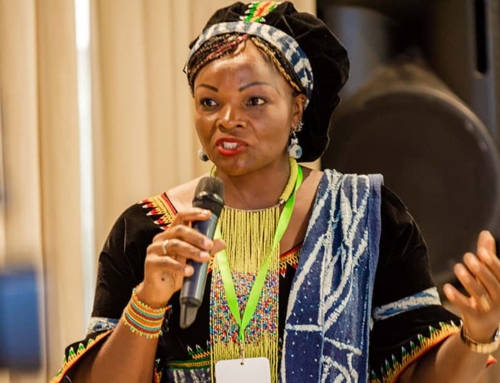The latest in our series of Deeper Thinking webinars focused on the concept of Flourishing Diversity, which lies at the heart of our newly unveiled Biocultural Diversity Programme (formerly the Flourishing Diversity Programme). We were joined by an inspiring panel of speakers who shared their knowledge and experience, exploring what flourishing diversity means to them and reminding us how ecological and cultural diversity are inextricably linked.
This event, chaired by Synchronicity Earth founders Jessica and Adam Sweidan, explored these diverse viewpoints with Katy Scholfield – creator of our new Biocultural Diversity Programme – and Katy Molloy, Director of Flourishing Diversity – in conversation with Dr Million Belay, Co-ordinator of the Alliance for Food Sovereignty in Africa (AFSA), Kerexu Yxapyry and Tiago Karaí, Comissão Guarani Yvyrupa (CGY).
What does ‘Flourishing Diversity’ mean?
As you listen to our wonderful speakers this evening, it will become clear that flourishing diversity means something slightly different to everyone. And that is the point.
Jessica Sweidan
In February, Katy Scholfield wrote about the origins of Synchronicity Earth’s new Biocultural Diversity Programme and how the interconnections between biodiversity, culture, and language had become ever more apparent through her career as a conservationist, leading to an increasing focus – in her own work, and in Synchronicity Earth more broadly – on the idea of cultivating biocultural diversity.
The value of biocultural diversity is slowly being reflected within the conservation community as the correlation between thriving cultures and wildlife is finally being recognised.
It’s about encouraging, restoring and protecting abundant biodiversity while acting with regard and respect for the natural cycles of life, and critically, with regard for the multitude of human cultures and practices that exist across our world.
Jessica Sweidan
Landscape, language and knowledge
Dr Million Belay is Co-ordinator of one of our Biocultural Diversity partners, the Alliance for Food Sovereignty in Africa (AFSA). AFSA is a broad alliance of civil society actors working to promote food sovereignty and agroecology in Africa. With over two decades on intergenerational learning of biocultural diversity and sustainable agriculture, Million shared his thoughts of where the relationships between landscape, language and knowledge come into practice.
Culture is the shepherd who has overseen the direct selection of plants and animals, and reworked whole landscapes. There are a number of cultural practices in play on any given landscape, and when you look and understand how a landscape is managed, you can see clearly how culture impacts landscape, and how the landscape also impacts culture. The two are interrelated.
Dr Million Belay
He went on to discuss how language also shapes our knowledge and holds the history of the relationship between people and the landscape they live alongside. Ecosystem services is often criticised as a one-way transaction with nature – what can nature do for us? But Million says:
There is a reciprocity between ecosystem services and cultural services. When people talk only of ecosystem services, they talk only of a one-way flow of services, with a healthy ecosystem giving provisioning services like food, fresh water, and fuel; regulating services like climate regulation; and cultural services including spiritual, religious, recreational, tourism. But researchers have also looked at the contribution of culture to the ecosystem and this is so important: weeding, culling, ritual regulations and cultural prohibitions, cultivation, domestication, trade selection, translocation and all the restoring services people provide through soil and water conservation activities, habitat and niche regeneration such as planting.
Listen to Million Belay:

Tiago Karaí, a young leader of the Tenondé Porã Indigenous Land, situated south of São Paulo state’s capital.
Recognising land rights
Tiago Karaí spoke about the consequences of his community losing access to their ancestral lands. He is a young leader of the Tenondé Porã Indigenous Land, situated in the south of São Paulo state’s capital. He is part of the Guarani Yvyrupa Commission (CGY) coordination and represents a new generation of Guarani leaders in the struggle for land titling.
We were living in an area of 26 acres, about 26 football fields and confined to just this for a really long time. It meant that we were not able to develop our culture or our traditions as we wanted to, and we fought to ensure our land tenure so we could secure our territory, which happened in 2016.
Since the new boundary demarcation recognising our rights to a much larger area (16,000 acres) we have been able to strengthen our culture and our practices, but also recognise how much we had lost when we were confined. We lost seeds. The loss of seeds meant a loss of food, sacred food, and we are only now recovering, able to strengthen our seed stores, our cultural knowledge, and once more protect our environment, our territory.
For us, it’s very important to have (…) tenure of our land, to be able to continue to keep our culture to survive as peoples, not only in terms of culture, but also spiritually because we have this connection between the Earth and our communities.
Tiago Karaí (audio via interpreter)
Food safety and security was also discussed by Kerexu Yxapyry, a leader of the Morro dos Cavalos Indigenous Land in Santa Catarina state.
Our food safety and security is very important. We have many different types of corn, sweet potatoes, beans, potatoes, and watermelons, and these varieties strengthen our spirit as well as reflecting our identity.
Kerexu Yxapyry (audio via interpreter)
The combined issues of Brazil’s current government and the COVID-19 pandemic have made the struggles for the land rights, safety and security of Indigenous Peoples much harder.
In many areas of Brazil, it is the Indigenous communities who are really keeping biodiversity in mind, protecting the environment and maintaining the continuity of rivers, of plants, of trees, to keep the riches of the land. Because Indigenous Peoples are the keepers of the land. But it is very difficult for us in Brazil currently to hold onto our rights. We have capitalism against us, consumerism against us.
But before all these challenges, we are resisting. We are standing our ground and fighting to survive together with nature, because we can’t just look after people if we are to survive, we must take care of the planet as well.
Tiago Karaí
Listen to Tiago Karaí (English audio via interpreter):

Kerexu Yxapyry, one of the main female leaders of the National Articulation of the Indigenous Peoples in Brazil (APIB) – the biggest national Indigenous movement.
Kerexu Yxapyry also spoke of the fight to protect the land of the Guarani people in Brazil, and particularly how important it is to collaborate between communities to strengthen their collective voice. Kerexu is part of the Guarani Yvyrupa Commission (CGY) coordination and is one of the main female leaders of the National Articulation of the Indigenous Peoples in Brazil (APIB) – the biggest national Indigenous movement.
Here in the state of Rio Grande we are in Indigenous lands, Guarani lands, and we are really fighting to keep our territory. We work in a very specific way to strengthen this fight, collaborating with all of our communities and when we protect our lands, we protect our souls, our spirituality. We believe that we can only achieve this by working together, and we will only have succeeded when the ecosystems are working in a complete and integrated way. So, when something is missing, there is a part of us that is missing as well.
For us, we don’t separate anything from nature, we believe that everything is nature. Everything that breathes, that is alive, the land, or elements, is part of nature and a part of us. We are one and in that sense, we maintain our belief as Guarani people, as Indigenous Peoples, that we must continue to fight for our land, our territory, and for our nature.
Kerexu Yxapyry
Listen to Kerexu Yxapyry (English audio via interpreter):
Taking action for the Flourishing Diversity movement
Katy Molloy is the Director of Flourishing Diversity, a sister initiative to Synchronicity Earth’s Biocultural Diversity Programme, which is an ecosystem of people, communities, organisations and ideas celebrating and cultivating biocultural diversity. This initiative began as a series of events in 2019, inviting Indigenous leaders to speak about their experiences protecting their environments.
Listening, I feel an immense gratitude and hope to learn from these cultures that have maintained this deep wisdom regarding human interconnection with the lands and waters and the forests and our fellow species. I also feel grief. Grief for all the challenges that they are living day to day and also for the absence of these truths in the narratives that I grew up with.
Katy Molloy

Kerexu Yxapyry speaking at the Flourishing Diversity Series held at the University College London.
Flourishing Diversity seeks to bridge the communications gap between Indigenous communities, with the knowledge held within their culture and history, and conversations around the environment in Western society.
In this time of accelerated global change, many more people are seeking solutions to address the mounting consequences of biodiversity loss and climate change. And yet, many of the voices being consulted and making decisions remain those who are raised within a cultural mindset that excludes nonhumans, when prioritizing concepts of future and progress and development.
Katy Molloy
Listen to Katy Molloy:
So how can readers be a part of this shift towards a thriving biocultural diversity?
Listening to the stories of Indigenous Peoples and calling out the absence of their voices in forums where they should have a platform, is one step. Some of our Biocultural Diversity partners are active on social media (such as the Alliance for Food Sovereignty in Africa (AFSA: Facebook, Twitter, Instagram), Comissão Guarani Yvyrupa (CGY: Facebook, YouTube), and the National Articulation of the Indigenous Peoples in Brazil (APIB: Facebook, Twitter)) who you can follow to learn more about their experiences and the important work they are doing, and signing up for updates from the Flourishing Diversity platform can keep you informed of any events like this Deeper Thinking panel with interesting discussions around biocultural diversity.
We’ve only recently launched this programme, but we’re already supporting 15 partners across these three programme goals, with a number of those straddling some of our existing Synchronicity Earth programmes. We’ve been able to do this by collaborating with a handful of very aligned funders to seed fund this important work. There are still some important gaps, including some matched funding opportunities, so if anyone wants to join us, please do get in touch.
Katy Scholfield
Listen to Katy Scholfield:





